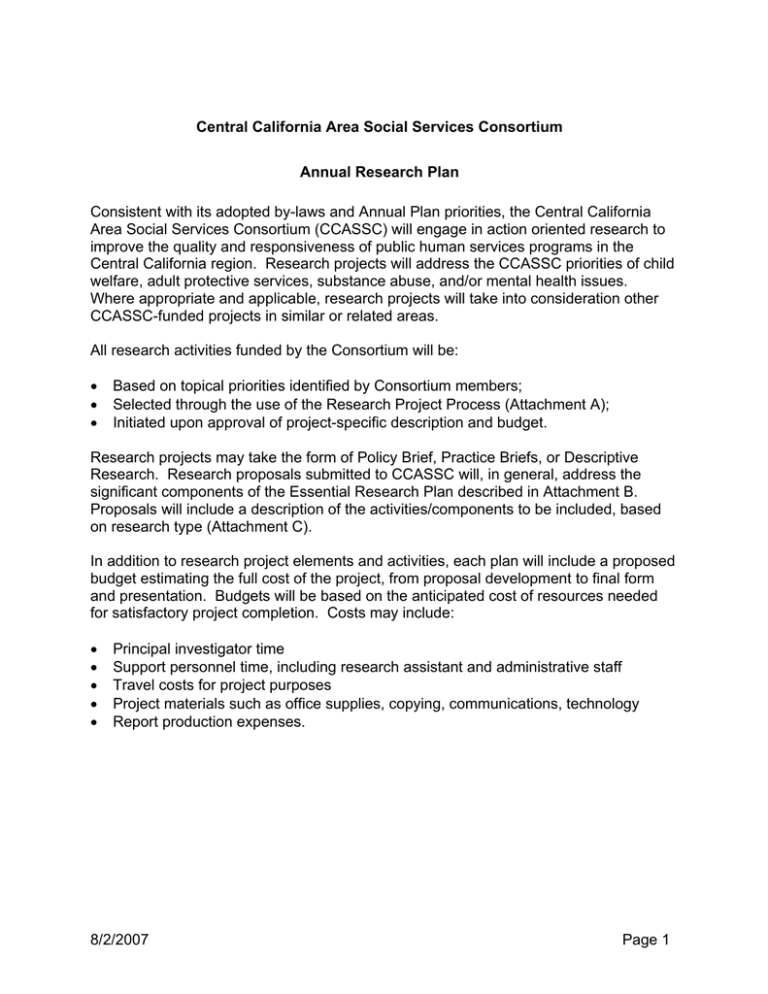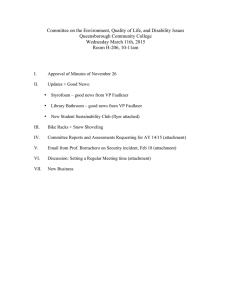Consistent with its adopted by-laws and Annual Plan priorities, the... Area Social Services Consortium (CCASSC) will engage in action oriented... Central California Area Social Services Consortium
advertisement

Central California Area Social Services Consortium Annual Research Plan Consistent with its adopted by-laws and Annual Plan priorities, the Central California Area Social Services Consortium (CCASSC) will engage in action oriented research to improve the quality and responsiveness of public human services programs in the Central California region. Research projects will address the CCASSC priorities of child welfare, adult protective services, substance abuse, and/or mental health issues. Where appropriate and applicable, research projects will take into consideration other CCASSC-funded projects in similar or related areas. All research activities funded by the Consortium will be: • • • Based on topical priorities identified by Consortium members; Selected through the use of the Research Project Process (Attachment A); Initiated upon approval of project-specific description and budget. Research projects may take the form of Policy Brief, Practice Briefs, or Descriptive Research. Research proposals submitted to CCASSC will, in general, address the significant components of the Essential Research Plan described in Attachment B. Proposals will include a description of the activities/components to be included, based on research type (Attachment C). In addition to research project elements and activities, each plan will include a proposed budget estimating the full cost of the project, from proposal development to final form and presentation. Budgets will be based on the anticipated cost of resources needed for satisfactory project completion. Costs may include: • • • • • Principal investigator time Support personnel time, including research assistant and administrative staff Travel costs for project purposes Project materials such as office supplies, copying, communications, technology Report production expenses. 8/2/2007 Page 1 Central California Area Social Services Consortium ATTACHMENT A Research Project Process 3/07/07 CCASSC members/staff identify a problem, issue, or current/emerging trend: 1. Does it have both regional and statewide impact? 2. CCASSC defines the type of Information/data needed. YES, regional and statewide: CCASSC recommendation to statelevel researchers, e.g. CFPIC, CALSWEC, etc. NO, regional impact only. Can the information/data be satisfied by a review of the literature, best practices, models or programs? Yes, go to 3a. No, Consider 3b. 3a. Review of Literature/Best Practices/Models/Programs Discuss Scope, methodology, practicalities, conceptualization, inclusion & exclusion criteria, cost, product expectations & final report. Final Result YES: Is external funding Available? YES: Best resource for project completion (county, regional universities, other)? . NO: CCASSC invest in funding review? YES: Best resource for review(county, regional universities, other) NO: no further action Yes, Information/data needs satisfied NO CCASSC linkage with statelevel resources and/or no further action Go to Step 2. If No to reviews or research, consider alternatives or no further action needed. Complete the review/report If funded, complete the review/report No further action needed Back to Step 2 3b. Research Needed: CCASSC defines the research question(s) Discuss Scope, methodology, practicalities, conceptualization, inclusion & exclusion criteria, cost, product expectations & final report. Final Result 8/2/2007 YES, Is external funding available? YES: Best resource for research completion (county, regional universities, other)? . NO: CCASSC invest in funding research? YES: Best resource for research(county, regional universities, other) Complete the research/report If funded, complete the research/report. NO: no further action YES, question answered. No further action. NO, research still needed. Back to Step 2. Page 2 CCASSC Annual Research Plan ATTACHMENT B 1 Essentials of the Research Plan Describe how proposed research will be conducted. Project-specific research plans will include: A. Research Question B. Background and Significance C. Research Design and Methods The research plan should address the following questions: What is the project intent? Why is the work important? What has already been done? How are you going to do the work? • • • • Research Question A formal statement of the question to be answered or issue to be clarified. This section clearly and concisely describes what the proposed research is intended to accomplish. • Should include specific research objectives. • Objectives should be obtainable within the proposed timeframe. • Study aims should fit together in an overall framework. • Study should be well-focused rather than broad and diffuse. Background and Significance States the research problem, including the proposed rationale, current state of knowledge and potential contributions and significance of the research to the field. • Critically evaluate existing knowledge, including background literature and relevant data. • References should reflect an updated knowledge of the field. • Specify existing gaps that the project is intended to fill. • Discussion should convey the importance and relevance of the research aims. • Highlight potential policy or practice impacts. • Highlight why research findings are important beyond the confines of the specific research project (e.g., significance; how research results can be applied). Research Design and Methods Describes how the research will be carried out; demonstrates a clear, organized and thoughtful study design. Should provide an overview of the proposed design and conceptual framework. • Study goals should relate to proposed study hypotheses. • Include details related to specific methodology; explain why the proposed methods are the best to accomplish study goals. • Describe any novel concepts, approaches, tools or techniques. • Include details of how data will be collected and results analyzed. • Consider required statistical techniques. • Include proposed work plan and timeline. • Consider and discuss potential limitations and alternative approaches to achieve study aims 1 Excerpts from Essentials of the Research Plan. Agency for Healthcare Research and Quality, Rockville, MD. http://www.ahrq.gov/fund/esstplan.htm 8/2/2007 Page 3 CCASSC Annual Research Plan ATTACHMENT C Research Projects and Activities Policy Briefs: • Executive Summary • Table of Contents with lists of tables/figures • Introduction • Background/Purpose of Research • Literature Review • Identification of Related Policies/Key Legislation • Presentation of Available Data • Discussion related to purpose of research • Implication for Policy/Legislation • Conclusions/Recommendation • References Practice Briefs: • Executive Summary • Table of Contents with lists of tables/figures • Introduction • Literature Review • Identification of related Best Practices Programs/Models • Presentation of Available Data • Discussion related to purpose of research • Implication for Practice • Conclusions/Recommendation • References Descriptive Research: • Executive Summary • Table of Contents with lists of tables/figures • Introduction • Background (identification of topical areas) • Demographic/descriptive data • Results of Analysis • Limitations of findings • Discussion of proposed strategies/conceptual frameworks • Recommendations • Conclusion • References • Appendices 8/2/2007 Page 4
